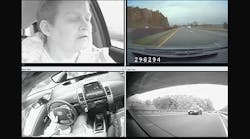Feeling fatigued? Pour yourself another cup of coffee and think twice before you get behind the wheel. A new study from the Virginia Tech Transportation reveals that 20 percent of car crashes are caused by fatigue, with young drivers particularly vulnerable to driving while fatigued.
Previous estimates attributed fatigue to only 2 or 3 percent of crashes.
“The study allowed us, for the first time, to observe driver behavior just prior to a crash. In 20 percent of all crashes and 16 percent of all near crashes, the driver was showing fatigue. We saw eye-lid closure, head bobbing, severe loss of facial musculature, micro-sleep – which is when your eyes drift shut and then pop up,” said Charlie Klauer, group leader for teen risk and injury prevention at the transportation institute’s Center for Vulnerable Road User Safety. “This was not just yawning. The drivers were asleep.”
The study also revealed that 18- to 20-year-olds account for significantly more fatigue-related crashes than any other age group. Adolescents’ sleep patterns shift to later hours; however, the school day starts early, resulting in daytime sleepiness. Older drivers can face similar issues with late nights and early work times, but often have more experience coping with moderate fatigue.
“A finding that surprised people is the prevalence of fatigue during the day,” added Klauer. “We found significantly more crashes/near crashes due to fatigue during the day than at night.”
Studying Fatigue
The naturalistic driving study focused on 100 drivers who commuted into or out of the Northern Virginia/Washington, D.C., metropolitan area. These drivers initially were recruited as primary drivers to have their vehicles instrumented or receive a leased vehicle instrumented for the study. Since other family members and friends would occasionally drive the instrumented vehicles, data were collected on 132 additional drivers.
The study used a data acquisition system with sensors that included five video channels, forward and rearward Vorad radar units, accelerometers, lane-tracking software and an in-vehicle network sensor. The cameras were mounted unobtrusively in order to facilitate naturalistic driving behavior. Researchers viewed more than 110,000 events in order to validate 10,548 events – specifically, 82 crashes, including 13 where the data was incomplete; 761 near crashes; 8,295 incidents, such as braking hard for slowing or stopped traffic; and 1,423 non-conflict events, such as running a stop light with no traffic present.
The total number of subjects who were involved in fatigue-related crashes and near-crashes was 38, with 11 drivers accounting for 58 percent of all the fatigue-related crashes and near-crashes.
“Applying the findings to the population at-large, these results suggest that drivers are at a four times greater risk of a crash or near-crash if they choose to drive while fatigued,” said Tom Dingus, director of the Virginia Tech Transportation Institute.
